Apr 13, 2025
Apr 13, 2025
The Irresistible Iran- 1
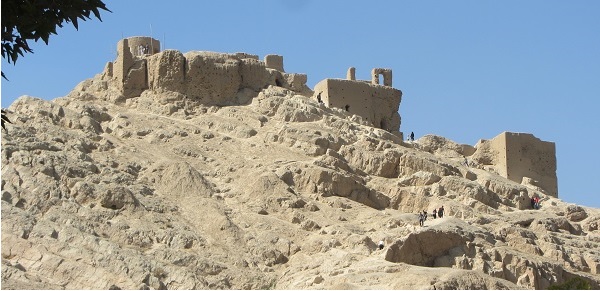
When I decided to go to Iran, I didn’t know much about that country except that I have enjoyed many Iranian films of international repute by great directors like Moshen Makhmalbaf, Abbas Kiarostami, Jafar Panahi and Majid Majdi. Perhaps the only other connection was through the poetry of famous Persian poets like Rumi , Sa'di and Hafiz.
I charted out my entire trip in two days early this month. Luckily there was this travel agency Touran Zamin in Tehran who rose up to my expection in arranging VISA within a day and devising a fine seven days tour plan to explore Iran. I flew by Qatar airways from Doha and after 1 hrs and 45 minutes, I landed in a country looked upon by the world with mistrust, fear and antipathy. A smiling guide promptly received me at the airport and thus began my unforgettable tour of Iran.
World thinks that Iranians are all religious extremists sitting on nuclear weapons with beards down to their bellies and mouths full of malice. What I saw in Iran in seven days was antithetical of what is projected by USA and the western media. Nowhere on this earth have I come across such warm, cultured, respectful and helpful citizenry as in Iran. I was struck by the cosmopolitanism of urban Iranians, their education, open-mindedness and their humorous irreverence about politics. The most beautiful women in the world are surely the peerless Persian beauties. Women strutting on the streets seemed like mannequins that came electrifyingly alive before my eyes. Women dye their hair in all colors and are a vibrant presence in all walks of life. I saw college boys and girls freely mixing together and laughing in coffee shops and gardens. Streets are clean and no beggars were seen anywhere. Baazars bustle with commerce and gaiety. Iran has all the fruits and nuts of the world and I couldn't take my eyes from the persimmon tree with hundreds of ripe and red seedless persimmons hanging from every branch in the sublime garden of Abbasi hotel in Isfahan.
Iran is perhaps the safest country in the Orient as I covered 1100 KMs by car to get a firsthand experience of the country side. Despite sanctions, I never encountered any mugging or deceptive invitations anywhere (Iranians are honest and my guide says villagers are better off than some city folks). Everywhere, I saw only the positive, beaming and welcoming faces of Iran and never any shred of animosity, apprehension, apartheid or fanaticism in tone or behavior. I believe the Iranian culture, nature, hospitality and infrastructure very well deserves a much larger number of tourists to visit the country.
This travelogue is conceived in three parts and under this part I, will cover the enchanting city of Isfahan.
Isfahan
If you’re going to get lost, Isfahan (also spelled Esfahan), a city of 1.5 million (not much as Iran has one of the lowest population growth among Islamic countries) about 200 miles south of Tehran in central Iran, is an extraordinary place to do it. There’s a centuries-old saying that Isfahan is “half the world,” meaning it contains fully half of the earth’s wonders. Jean Chardin, a 17th-century French traveler, wrote that Isfahan “The greatest and the most beautiful town in the whole of Orient” and “was expressly made for the delights of love”. In the 1930s, the British travel writer Robert Byron rated it “among those rarer places, like Athens or Rome, which are the common refreshment of humanity.” Here is a city that rivals the marvelous churches and domes of Florence and overwhems you with its trascendental beauty.
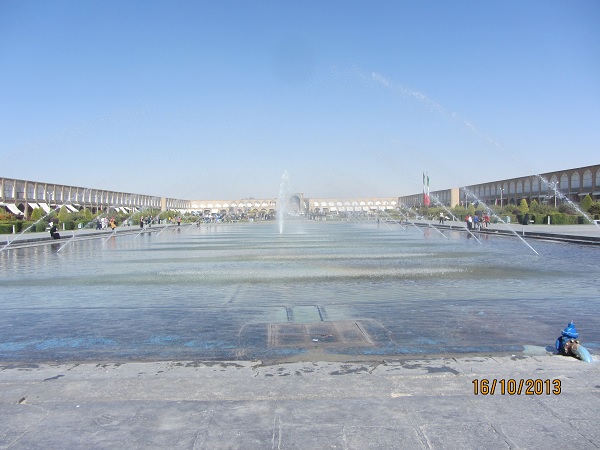
Imam Sqaure -View from the fountain
Isfahan is thus one of the oldest cities of the world with a history of 2500 years. The city has experienced many changes as capital of two great Islamic Empires: Seljukid and Safavid. Although the city was the result of two immense urban plans in the eleventh and seventeenth centuries, the golden age of Isfahan was in the Safavid era. Isfahan served as Persia’s capital of Safavid dynasty from 1598 to 1722 and was once one of the largest cities in the world during that period. The city is famous for its imposing Islamic architecture, with many beautiful boulevards, covered bridges, incredible mosaic-covered mosques, palaces, and minarets. In my opinion, this city, apart from its artistic splendour , possesses a quaint charm that cajoles us to stay longer.
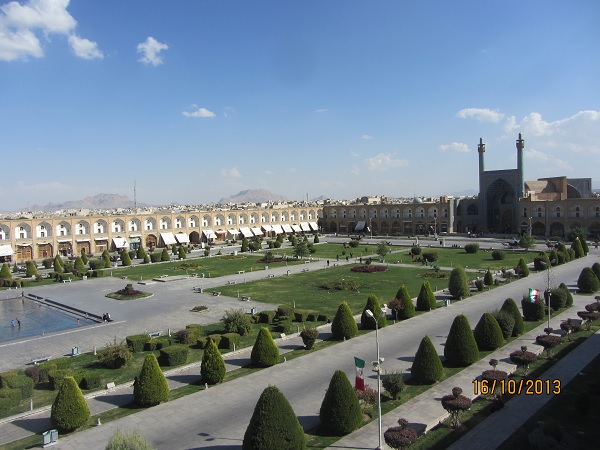
View of Imam Square
Isfahan was the dream city built by the King Abbas the great, considered the greatest ruler of the Safavid dynasty. In 1598, when Shah Abbas decided to move the capital from the northwestern city of Qazvin to the central city of Isfahan, he initiated what would become one of the greatest programmes in Persian history; the complete remaking of a city. Powerful Shah Abbas transformed a sleepy Persian village into a world center of legendary beauty and far-flung commerce. The Chief architect of the colossal task of urban planning and the conception of Naqsh-e Jahan Square (now known as Imam Square) was Sheikh Bahai. He was a scholar, philosopher, architect, mathematician, astronomer and poet in 16th-century Iran. His mastery of topography and city planning was astonishing. By choosing the central city of Isfahan, fertilized by Zayandeh River lying as an oasis of intense cultivation in the midst of a vast area of arid landscape, King Abbas the great both distanced his capital from any future assaults by the Ottomans and the Uzbeks, and at the same time gained more control over the Persian Gulf, which had become an important trading route for the Dutch and British East India Companies.
Under King Abbas the great, Isfahan became one of the most beautiful cities in the world. As Roger Savory writes, “Not since the development of Baghdad in the eighth century A.D. by the Caliph al-Mansur had there been such a comprehensive example of town-planning in the Islamic world, and the scope and layout of the city centre clear reflect its status as the capital of an empire.” Isfahan became the centre of Safavid architectural achievement, with the mosques Masjed-e Shah (after the 1979 revolution called Immam Moque) and the Masjed-e Sheikh Lotfollah and other monuments like the Ali Qapu, the Chehel Sotoun palace, and the Naghsh-i Jahan Square.
The Naghsh-e Jahan Square in Isfahan , built between 1598 and 1629, is one of the largest city squares in the world and an outstanding example of Iranian and Islamic architecture. Said to be three times the size of St. Mark’s square in Venice, this immense open space of 500 x 160 M now has lawns and fountains. It was once used as a ground for Polo matches. The Imam square is now World Heritage Site under UNESCO.
At the north end of Naghsh-e Jahan Square is the main entry into the great Bazar of Isfahan, facing the Masjid-i-Imam on south end. At the east end with its coffee-colored dome is Masjid-I Shaikh Luftullah and opposite on the west side, Shah Abbas created the noted six-storey palace named Ali-Qapu which dominates the eastern side. Visit to all the square and all the three monuments and the grand Baazar would take a minimum of 5 hours. I was lucky to a get a guide who was a 65 year retired teacher of persian history. His pace of narration coupled with engaging and effusive dialogues kept me in rapt attention as he explained the glorious past of this historical site. Here are some glimpses of the treasures that this gorgeous city offers.
Chehel Sotoon Palace
West of Ali Qapu palace is the most surviving Safavid Pavilion, Chehel Sutun (40 or ‘many’ columns) palace. There are twenty columns laid out in three rows of six with two additional ones on either side of the main entrance of this palace. When these are reflected in the water of the pond in front of the porch, the number is made up to forty, the Persian for which is “chehel”. It was built as a pleasure pavilion and reception hall, using the Achaemenid-inspired talar (columnar porch) style. It was built in 1647 under the watch of Shah Abbas II. The 16m-high columns, once painted and gilded with mirrors, used to be hung with curtains sprayed with rose water to perfume the air.
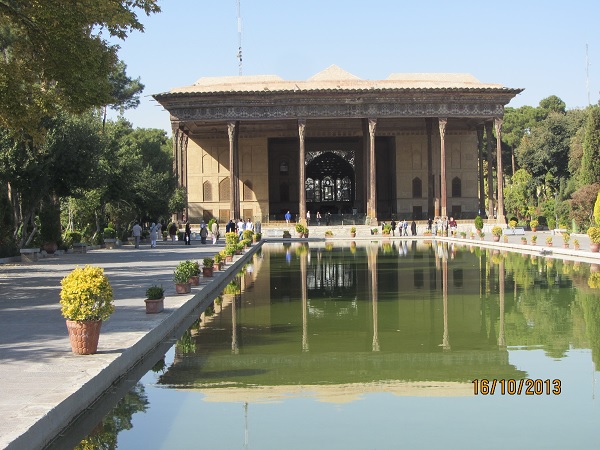
Chehel Sotoon Place-Front view
As we enter the main hall or the audience chamber, we are greeted by richly decorated wall paintings on all sides celebrating the heyday of the Safavid dynasty, including a particularly celebrated one of Shah Tahmasb receiving our Mughal Emperor Humayun at a banquet (You may remember that Humayun fled to Persia after surrender to Sher Shah Suri). The two largest paintings are depicting the Karnal battle between Nader Shah Afshar and Mohammad Shah Gurkani, king of India, which led to conquest of Delhi and India by the Persian king and The battle of Chaldoran between Shah Esmaeel Safavid and the Ottoman ruler Sultan Salim.
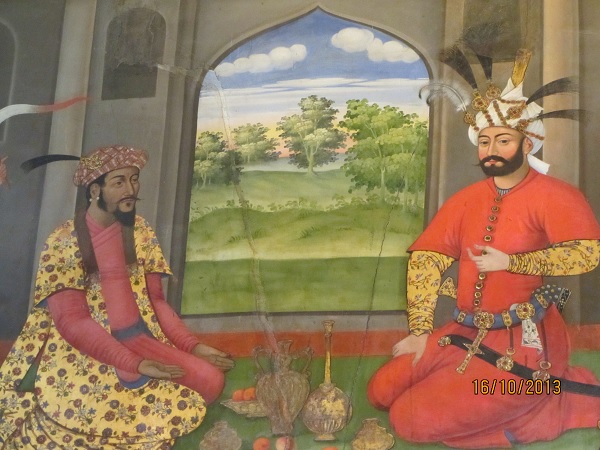
Persian King receiving Mughal emperor Humayun (left)
The garden of this palace is splendid and a fine example of the Persian Gardens and the whole complex is designated as UNESCO World Heritage monument.
Ali Qapu Palace
Aali Qapu (“Great Gate”) is a grand palace. It is located on the western side of the Naqsh-e Jahan Square opposite to Sheikh Lotf-allah mosque, and had been originally designed as a vast portal. This Palace was built in the 17th century to give Shah Abbas II a magnificent view over the square and it still offers one of the best views there is. You can imagine what it was like to watch a polo game on the square from here. This palace looks enigmatic as different side views gives the impression that it has three, four or five floors while in truth it has six floors and the fifth floor is apparently hidden.
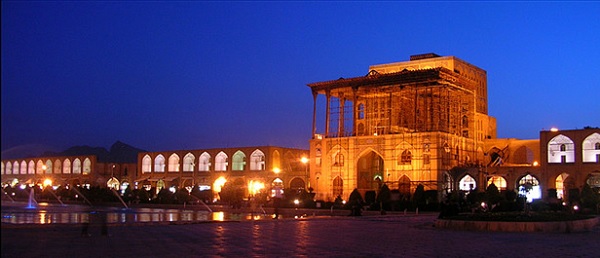
View of Ali Qapu Palce
The sixth floor of Al-Qapu place is the most amazing room called “Music Room”. It includes a central hall in the form of cruciform with smaller halls on sides and several rooms with different spaces on the corners. The decorations are divided into two parts of painting and plaster molding at this section. What makes this hall an enthralling experience for our eyes is the amazing stuccowork and hollow plaster work aimed to enhance the acoustics of the room and eliminate echo. Thus the room are designed in this way so that high quality sounds can be heard in exactly the way it is produced. I must say that all Persian architects were well versed in mathematics, algebra and geometry and one can sense the proportions everywhere.
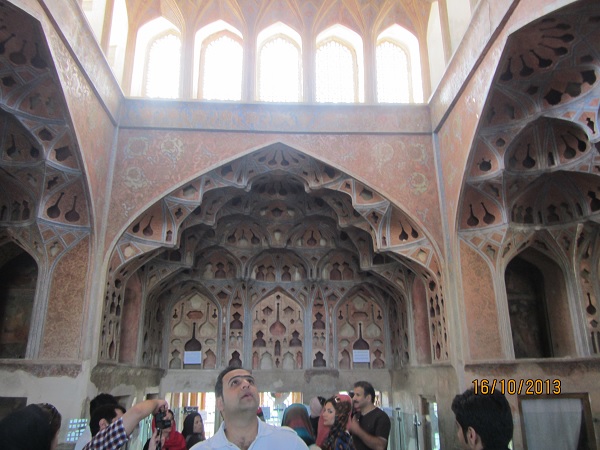
Music room at Ali Qapu palace (6th floor)
Masjid-i-Imam (Imam Mosque)
The Imam Mosque is the larger of the two mosques at Imam Square , the other being Sheik Lotfollah. The Imam Mosque is one of the most beautiful mosques in the world. The richness of its blue-tiled mosaic designs and its perfectly proportioned Safavid-era architecture form a visually stunning monument to the imagination of Shah Abbas I and the ability of his architect. The sumptuous decoration of the mosque perfectly complements the architectural elegance. Its tiled dome was covered by twirling black-and-white vines and turquoise flowers, a design with the precision more of fine china than of monumental architecture. A high, honeycombed arch known as an aivan, decorated with Quranic inscriptions and complex arabesques, caps the entryway.
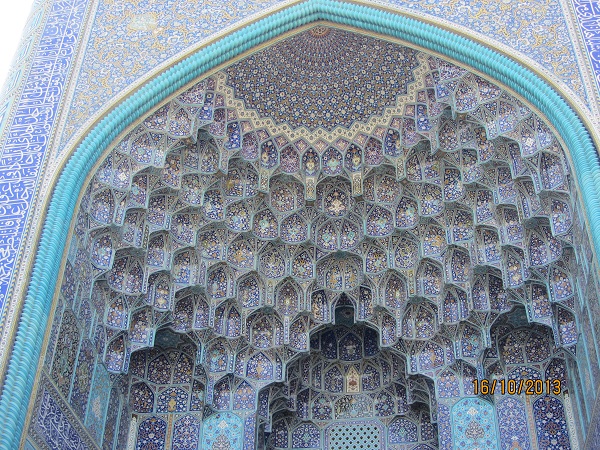
Aivan of Imam Mosque
Inside, a cool, dim passage led to a prayer sanctuary beneath the dome. Light filters in through screened windows, revealing glass and tile mosaics even more colorful and elaborate than those outside.
Sheikh Lotfollah Mosque
Right across the square from the Ali Qapu Palace is the Sheikh Lutfollah Mosque. This is a mosque that is different from all the others in Iran. It wasn't a public place of worship, but a private one mostly used by the women of the Shah. That is why it probably doesn't have any minarets. Furthermore, it isn't blue or turquoise but yellow. Inside, it is an unbelievable beautiful mosque.
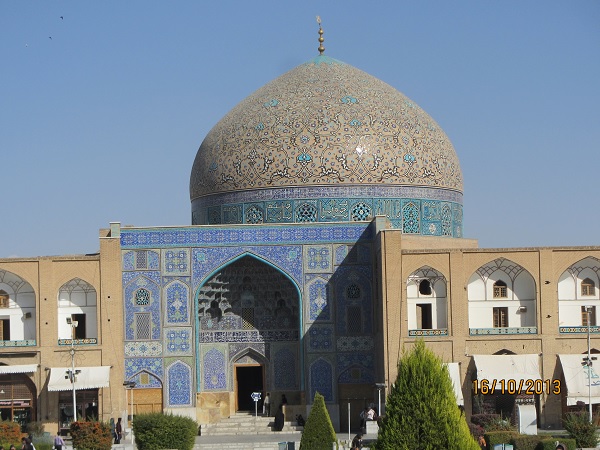
Sheikh Lutfollah Mosque
A study in harmonious understatement, this mosque is the perfect complement to the overwhelming richness of the larger Imam Mosque, and is arguably the most fabulous mosque in Iran. Built between 1602 and 1619, during the reign of Shah Abbas I, the Sheikh Lotfollah Mosque is dedicated to the ruler’s father-in-law, Sheikh Lotfollah, a revered Lebanese scholar of Islam who was invited to Isfahan to oversee the king’s mosque (now the Imam Mosque) and theological school.
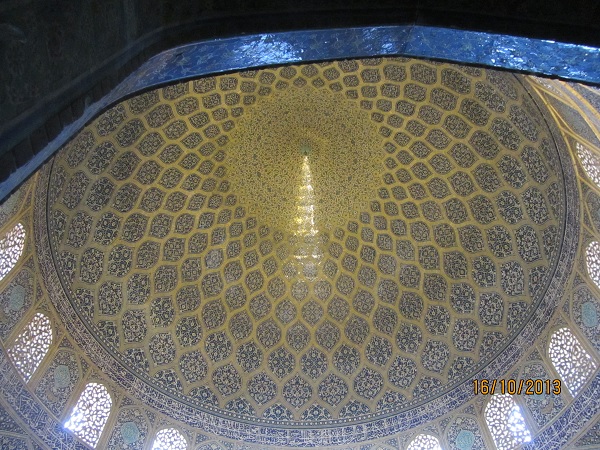
Sheikh Lutfollah Mosque - The Dome
The pale dome makes extensive use of delicate cream-coloured tiles that change colour throughout the day from cream to pink . Inside the sanctuary you can marvel at the complexity of the mosaics that adorn the walls and ceiling, which is extraordinarily beautiful with its shrinking, yellow motifs drawing the visitor’s eye into the exquisite centre. The shafts of sunlight that filter in through the few high, latticed windows produce a constantly changing interplay of light and shadow. As light falls on the ceiling , the blue, gold and other hues of tiles, the dome gives the impression of a peacock that has spread its plumage in all its splendor. The position of the viewing of the peacock image changes as the day progresses and it won't be visible from another location inside the sanctuary.
The pale tones of the cupola stand in contrast to those around the portal, where you’ll find some of the best surviving Safavid-era mosaics. The exterior panels contain wonderful arabesques and other intricate floral designs; those displaying a vase framed by the tails of two peacocks are superb. The portal itself contains some particularly fine stalactite work with rich concentrations of blue and yellow motif.
Bazaar-e Bozorg
The Bazaar of Isfahan, the heritage of the Saljuqid and Safavid era is one of the oldest and largest bazaars of the Middle East. It stretches between Imam Sq and the Jameh Mosque several kilometers away. The bazaar can be entered at dozens of points along its winding route, but the main entrance is via the Qeysarieh Portal at the northern end of Imam Sq. the high gateway is decorated with tiles and, higher up, frescoes by great Reza Abbasi, depicting Shah Abass’ war with the Uzbeks.
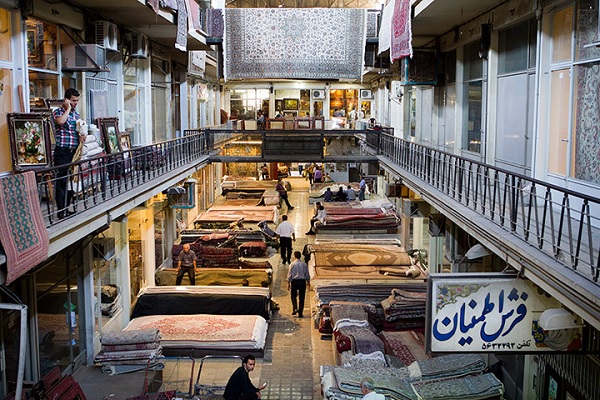
The grand Bazaar
Like most Iranian bazaars, Bazaar-e Bozorg is loosely divided into several interconnected corridors, each specializing in a particular trade or product, with carpet dealers, goldsmiths, samovar-makers, shoe makers, dyers, all having their own quarters. You can also find several mosques, tea shops, bathhouses, and even gardens. Small apertures in the vaulted roof let in sufficient light thereby keeping out the intense heat of summer while it retains the warmth during winter.
Jameh Mosque
The Jameh Mosque is a veritable museum of Islamic architecture and still a working mosque. I fell in love with this grand mosque. Compared to this, the Imam mosque discussed earlier seems garish and over decorated. The austere columns, aisles and domes of this mosque coupled with the dim light of its interior create a serene silence inviting us for prayer and meditation. Walking through the arcades of this mosque made me realize the breathtaking beauty of brickworks. Within a couple of hours of walk inside this mosque, you can see and compare 800 years of Islamic design, with each example near to the pinnacle of its age. The range is quite stunning: from the geometric elegance of the Seljuks (who ruled Isfahan), through to the Mongol period and on to the refinements of the more baroque Safavid style. At more than 20,000 sq meters, it is also the biggest mosque in Iran.
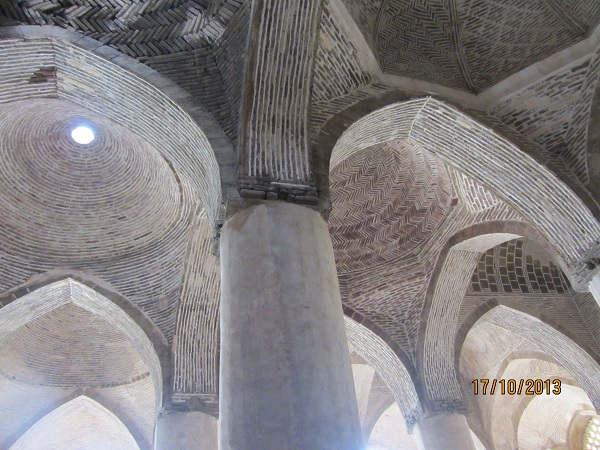
Columns and arches in Jameh Mosque
Religious activity on this site is believed to date back to the Sassanid Zoroastrians, and the first sizable mosque was built by the Seljuks in the 11th century. Of this, the two large domes above the north and south iwans (rectangular halls opening onto a courtyard) have survived intact, with most of the remainder destroyed by fire in the 12th century. The mosque was rebuilt in 1121, with later rulers making their own enhancement.
In the centre of the main courtyard, which is surrounded by four contrasting iwans, is an attractive ablutions fountain designed to imitate the Kaaba at Mecca; would-be haji pilgrims would use it to practise the appropriate rituals. The two-storey porches around the courtyard’s perimeter were constructed in the late 15th century. The south iwan is the most elaborate, with Mongol-era stalactite mouldings, some splendid 15th-century mosaics on the side walls, and two minarets. The north iwan has a wonderful monumental porch with the Seljuk’s customary Kufic inscriptions and austere brick pillars in the sanctuary. The west iwan was originally built by the Seljuks but later decorated by the Safavids. It has mosaics that are more geometric than those of the southern hall. The courtyard is topped by a maazeneh, a small raised platform with a conical roof from where the faithful used to be called to prayer.
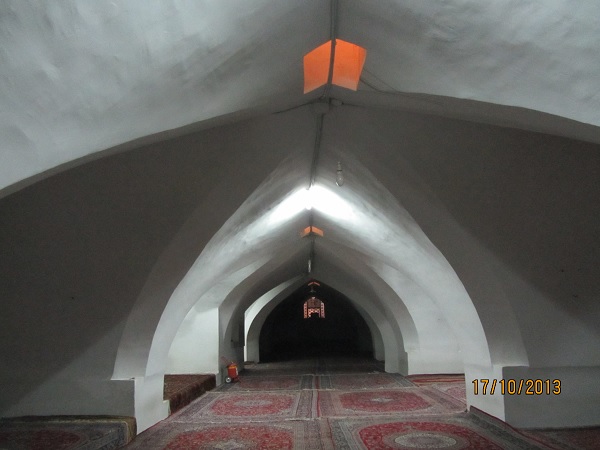
The Winter Mosque in Jameh Masjid (looks like a concrete desert tent)
To fully appreciate this mosque you must go into the fine interior rooms. The Room of Sultan Uljeitu (a 14th-century Shiite convert) is home to one of the mosque’s greatest treasures – an exquisite stucco mihrab awash with dense Quranic inscriptions and floral designs. Next door is the Timurid-era Winter Hall (Beit al-Sheta), built in 1448 and lit by alabaster skylights – ask the caretaker to turn off the neon (or do it yourself) to see the full effect.
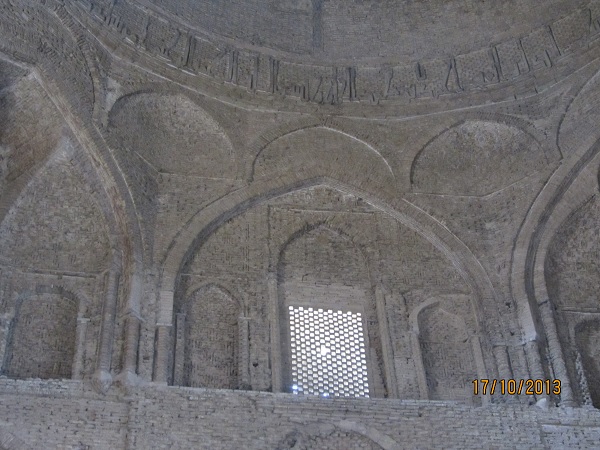
The gothic beauty of the interior of Taj al-Molk Dome
The room beneath the grand Nezam al-Molk Dome and the Seljuk-era hypostyle prayer halls either side just breathe history, while at the other end of the complex the Taj al-Molk Dome is widely considered to be the finest brick dome ever built. There is a Kufic inscription on the bricks of the dome that shows it dates back to 1088 A.D. While relatively small, it is said to be mathematically perfect, matching golden ratio (1.61) , and has survived dozens of earthquakes without a blemish for more than 900 years. Professor Arthur Upham Pope who has made a lot of researches on Iran says about Taj-al-Molk ,'This magnificent, silent, serious and mysterious monument is one of the most beautiful architectural works in the world.' To reach it you walk through a forest of imposing pillars. You could see astonishing brickworks as you walk, bricks packed like rows of books in a bookshelf. These domes are among the oldest parts of the mosque.
Khaju Bridge
Arguably the finest of Isfahan’s bridges, the Khaju Bridge was built by Shah Abbas II in about 1650 has 24 arches and central, two storied octagonal kiosk. I spent considerable time wtaching the ineffable beauty of this bridge from the inside and outside. Octagonal pavilions in the center of the bridge on both the down and the upstream sides offer remarkable views.
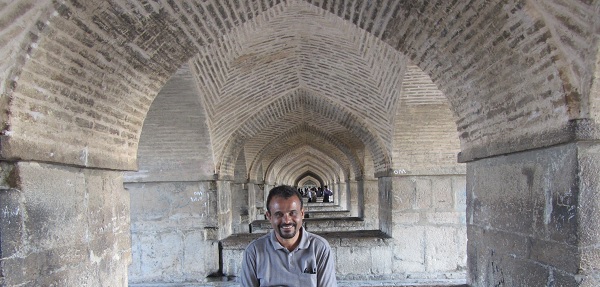
The beautiful arches of Khaju Bridge
Viewed from a vantage point on one bank, the bridge offers a miraculous the sight of a gap between arches on the lower level of the bridge transforming into a lit candle. The lower level is accessible on foot, provides a cool shady place for relaxing with endless view through its arches. The center niche at lower is a meeting point of youths and we witnessed talented youths singing traditional Persian poems and film songs. Their rendition was so beautiful that I and my guide spent some time listening to it. The bridge is well illuminated in the night and provides a beautiful sight.

Khaju Bridge at Night
Si-o-Seh Bridge
The 298m-long Si-o-Seh Bridge (Bridge of 33 Arches , 33 being number rosaries used during prayer) was built by Allahverdi Khan, a favourite general of Shah Abbas I, between 1599 and 1602 to link the upper and lower halves of Chahar Bagh St. It served as both bridge and dam, and is still used to hold water today.
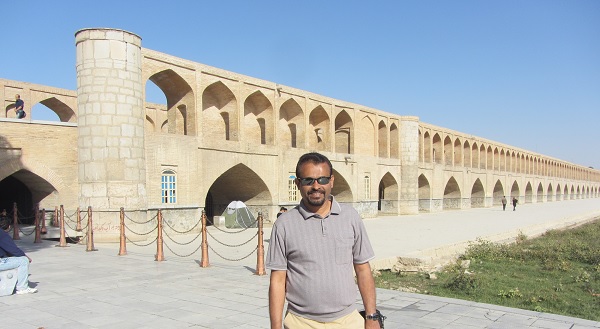
Si-o-Seh Bridge
Jolfa: The Armenian Quarter
The Christian community in Iran consists mainly of Armenians who settled, historically, at Jolfa, in the north of Iran, and were then moved to New Jolfa in Isfahan in Safavid times. The original Jolfa was once a major Armenian settlement famous for its skilled artisans. So skilled, in fact, that in 1604 Shah Abbas kidnapped the entire population, whisking them off to build him a new capital at Isfahan where their descendants still live.
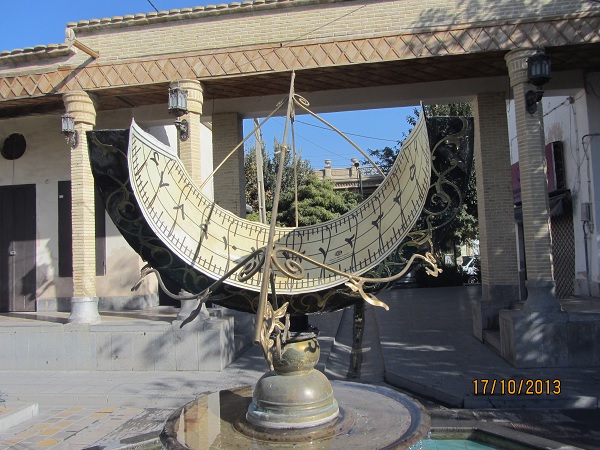
Sun Dial at Armenian Quarter
Abbas sought their skills as merchants, entrepreneurs and artists – a look at the walls of Vank Cathedral reveals what he was after. Today, Iran’s 250,000 Christians also include Roman Catholics, Adventists, Protestants and Chaldeans as well as about 20,000 Assyrians. The Armenian Christians had their religious freedom respected, but they were restricted to this area across the river and kept away from the Islamic centers. Today there are 13 Armenian churches and an old cemetery scattered around Jolfa, serving a Christian community of about 7000.
Vank Cathedral
One of the largest and most beautiful churches of Iran, the cathedral was completed in 1664 with the encouragement of the Safavid rulers. It includes a bell-tower, built in 1702, a printing press, founded by Bishop Khachatoor, a library established in 1884, and a museum opened in 1905.
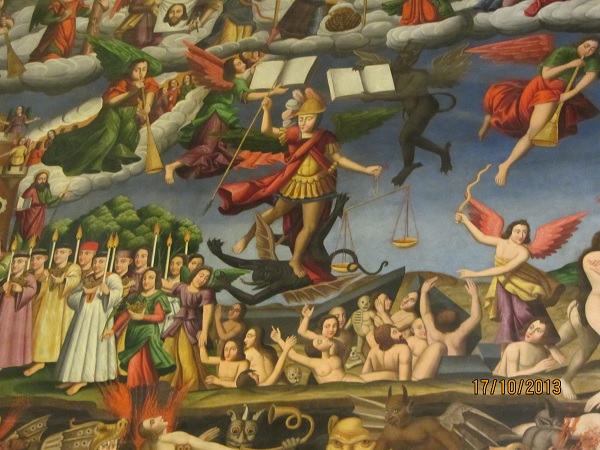
Part of the fresco of heaven and hell in Vank Cathedral
Vank Cathedral is the historic focal point of the Armenian church in Iran. The architecture of the building is a mixture of the 17th-century Safavid style with high arches and an Islamic-style dome. The main entrance of the cathedral is a large wooden door through which visitors enter the courtyard of the building. The church’s exterior is unexciting, but the interior is richly decorated and shows the curious mixture of styles – Islamic tiles and designs alongside Christian imagery – that characterizes most churches in Iran. The frescoes are truly magnificent, and sometimes wonderfully gruesome. The delicately blue and gold painted central dome depicts the Biblical story of creation of the world and man's expulsion from Eden. The ceiling above the entrance is painted with delicate floral motifs in the style of Persian miniature. Two sections run around the interior walls: the top section depicts events from the life of Jesus, while the bottom section depicts tortures inflicted upon Armenian martyrs by the Ottoman Empire and the torture cycle of St.Gregory the Illuminator under Armenian King, the King's later transformation into a pig and the saint pardoning him and accepting him into his fold.
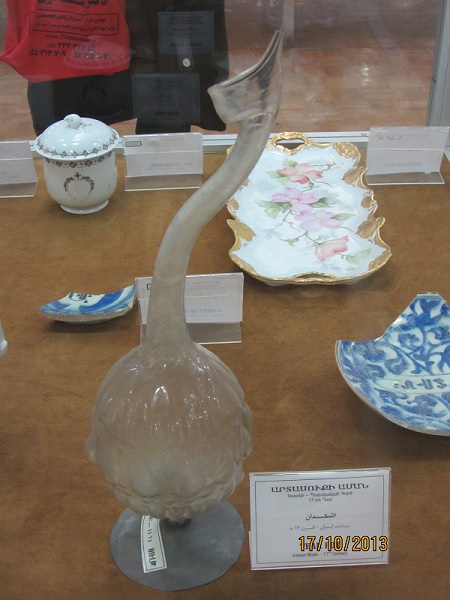
Tear Pot in Armenian Museum of Vank Cathedral
The Armenian museum which is an annexe of the cathedral is worth visiting as it holds many interesting artifacts and handwritten Gospels dating back to 12th century. Ancient Armeninas were great calligraphers and copymakers. Compared to printed Gospels of today, an illuminated masterpiece displayed here is what a Ford car is to the Parthenon. One artifact that held my interest was a tear pot dating back to 17th century. Armenian women were supposed to weep incessantly while their husbands were away on tour for trade or to fight wars and when they returned, the husbands would inspect the tear pot. The more the tears the more they were blessed with gifts.
Church of Bethlehem
This was built in 1628 and I found frescos here of a higher quality than those in Vank Cathedral. The interior of the high dome is decorated with swirling black motifs on a golden background, while the base is surrounded by paintings of Biblical scenes and tormented life of Armenians under Ottoman and the torture of St.Gregory the Illuminator.
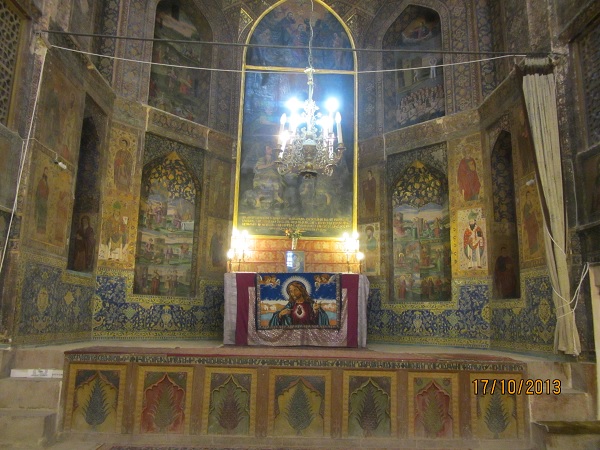
Interior of the church of Bethlehem
Shaking Minarets
The 14th-century tomb of Abu Abdullah, a revered dervish, is 7 km west of central Isfahan in Kaladyn. The tomb is popularly known as Manar Jomban because pushing hard against one minaret will start it, and the other minaret, swaying back and forth. The minarets were added during the 17th century. Attendants climb up to shake them once an hour, on the hour. No clear scientific explanation has yet been given why the minarets shake. Here also a beatiful garden of cypresses and pomegranates encase it.
The minaret of the Ali Mosque
On return from Jameh mosque, I saw a minaret more beautiful than Qutab Minar in Delhi. Erected during the reign of Seljuk sultan Sanjar (118-1157 CE), the miaret of Ali Mosque (The mosque was named after the first Shiite Imam Ali ) is the highest minaret in Isfahan, about 48 meters high, and decorated by two balconies. The shaft below the balconies is embellished with interlocking stars in recess, altering to a diamond pattern at the top end, four bands of Kufic inscriptions, three of which are highlighted with glazed tiles.
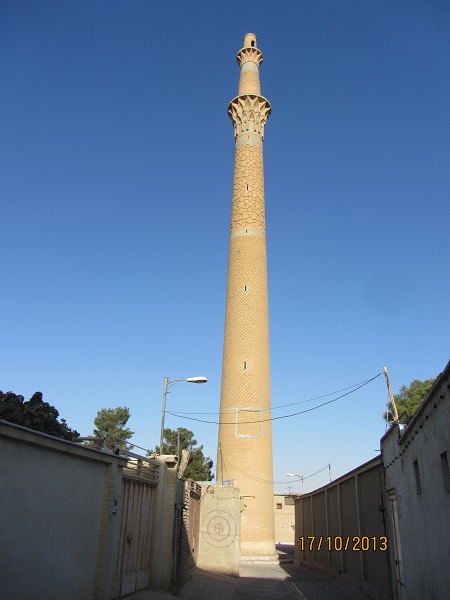
The minaret of the Ali Mosque
Hasht Behesht Palace
Once the most luxuriously decorated in Isfahan, the interior of the small Hasht Behesht Palace has been extensively damaged over the years. However, it retains a seductive tranquillity, with the soaring wooden columns on its open-sided terrace seeming to mirror the trees in the surrounding park. It has fine murals and spectacular roofs while retaining a domestic simplicity. It consists of an almost octagonal base on which four eivans are raised and four smaller sets of chambers, while the centre is surmounted by a spectacular ceiling. The exterior tilework is notable for its naturalistic style, depicting peacocks and angels alongside trees in a less stylized way than previous buildings, while inside there are charming murals on the walls and a further variety of spectacular ceilings.
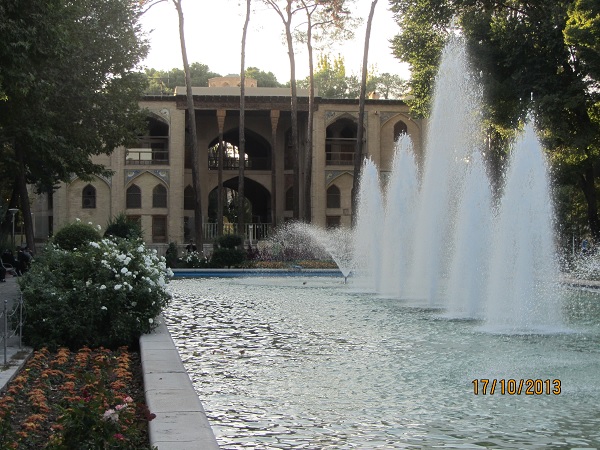
Hasht Behesht Palace
Qeysarieh Tea Shop
Sitting at the outdoor tables, sipping tea (IR5000 per person) and puffing qalyan (IR10,000) in Qeysarieh tea shop was the perfect way to wind up the enthralling experience that Isfahan offered. This tea shop is no ordinary one. It has the most astonishing collection of ancient objects, artifacts, currencies of all countries hanging from the walls and ceiling which gives it a magical ambience and supernatural aura.
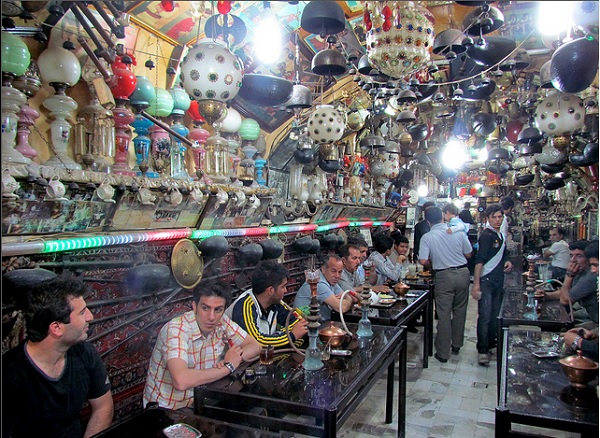
Qeysarieh Tea Shop
The Eternal Isfahan
Isfahan offers a lyrical charm despite the zig-zag traffic on streets and labyrinthine bazaar alleys. The city is liberally sprinkled with oases of lovely gardens and boulevards of tall cypresses, poplars and pine trees while sycamore maple trees adorn the streets offering a cool shade. Thus like music, the trees of Isfahan never lets us tired even after miles of walking. I and my guide took several rests in these gardens drinking delicious Iranian tea and chewing the Isfahan delights like Gaz and Sohan.
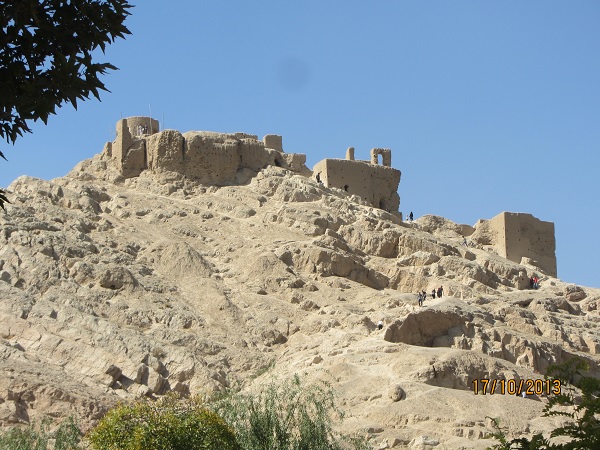
Fire temple belonging to Sassanid-era archaeological complex
located on a hill 210 M above the surrounding plain
Isfahan is indeed the Florence of Orient, Persia's masterpiece, the Intrigue of Iran and the half rhymed famous adage “Isfahan Nesf-e Jahan” (Isfahan is half the world) veritably describe the splendor of a city shining along its life-giving river at the heart of Iran. Andre Malraux, the famous French author and adventurer has said: “Who can claim to have seen the most beautiful city of the world without having seen Isfahan?” This pearl of Persia with its well-proportioned mosques and turquoise blue dome and minarets rivaling the color of the sky surely offers endless delights to any traveler.
27-Oct-2013
More by : P. G. R. Nair

|
Dear PGR, I thought for a while to decide a traditional place where I should take you for a round in Doha on your first day. I was delighted to hear that the Souq Waqif looks very much similar to the Souq you found in Iran. To my surprise I learned later that it is made by Iranians. You always surprise us with the vast knowledge you acquire & share with your unique style. It was great spending time with you and reading about the Irresistible Iran. Retchi |

|
Dear PGR Nair, What a wonderful report ! I actually love every sentence and picture in your report. You did an amazing job to tell us more about Isfahan and Shiraz. We are thinking to visit the same soon. All the best sir, we hope to see more travelogues in the future. Regards, Essam Al Ahmed MARAFIQ |

|
Excellent travelogue, PGR-ji. Thought I was myself on the trip with a fantastic guide. Eagerly awaiting the other parts. |

|
Dear PGR, While we had planned and visited several countries in the Middle East, Iran was never on our list. This was only due to our viewing the country with the "jaundiced eye" of the western media. Quite unfortunate! Your travelogue has opened up another "must see" location in our list!! Thanks for the wonderful write up. It makes it easy for us to plan and decide on the itenerary!! Regards, |

|
Dear PGR Your first hand experience of an credible oriental culture as evidenced from your travelogue has completely transformed my short-sighted view of Iran. The vividness with which you have portrayed the landscapes, social and cultural vignettes of a peace-loving country has left an enduring impact on me. Probably, I will consider spending a few few days of my annual vacation visiting Iran to enjoy the warmth of a friendly civilization. Thank you so much for the authentic information. |

|
Dear DTM PGR Sir Reading the travelogue was like virtually seeing them!!!! I have decided Iran is my next destination!!!! So I have to extend my stay here for another 10 years to earn enough. Thanks for sharing your experiences. You have indeed changed my preconceived notions & views about Iran. Regards Rajeev |

|
Thanks Syam, Waheed Shanmugham and sara |

|
Hi Nice text and beautiful pictures. Really i myself haven't seen some places which you saw in your trip! I'm eager to read the next part(Shiraz Part) |

|
Dear PGR, I wonder about your uniqueness & setting a trend on any action you take. This travelogue adds to that. I enjoyed glancing through. Thanks for sharing. I shall make a book mark of Iran in my travel plan. Regards |

|
Dear PGR, Peace be with you; Beautifully written travelogue, so comprehensive, your personal touch and your keen observation about the people’s beauty and country’s rich history and a few pictures posted in your article will make everyone to flock to visit Iran. Your remark on antithetical projection of Iran by USA and the western media is very bold, and that’s what we know PGR for being bold and just. Looking forward to the next 2 blogs on travelogue. Waheed Lateef |

|
Dear PGR Sir, Wonderfully scripted travelogue... mesmerising with its details . I have made up my mind to travel to this glorious land in the near future. Looking forward to the remaining part . Regards, S. Syam |

|
Thanks Basheer, Hani, Manoj, Jacob, Babu and S. Khan |

|
Dear PGRNair saab, Indeed, it came as a surprise when I read your travelogue. But deep in my thoughts, Iran was stamped as a country behind Iron gates as shown by media..... Added to it, it was like reading a poem when the travelogue came out through a your pen and caliber. Can't wait to read about Shiraz and Persepolis... Babu Sebastian. |

|
Hi PGR, Now am motivated to visit Iran. well composed article. Regards |

|
Great Traveloge, Would certainly visit Iran Regards Jacob, Abu Dhabi |

|
Thanks PGR for opting to tour Iran and write beautiful travelogue. Although, I am a fan of travelogues in Malayalam, from SK pottekkat to Santhosh George,this is first time I read about Iran. |

|
Mr. Nair Really you took me again for this place after almost 7 years was my family travel to ISFAHAN, TAHRAN, MASHAD and QUM. Iran something different and what you wort for such Ancient places with wandorful historical background. I advise you to visit MASHAHD city, and i want to see other places north of IRAN it is a beautiful area as well. in general iranian as a people are nice behaviour and life cost for us is resoanable . wish you all the best to see other cities in iran. |

|
Dear PGR...Very nicely depicted...This country was not in my list of priority of visiting.Now suddenly jumped as priority no.1. Awaiting the release of next part.. |

|
sasi arun kumar nair : Thank you! |

|
Nair sir , its altogether a different realistic picture of iran , as seen through your eyes than what is depicted by the western world !!! shall share the reading & photographs with my son naveen. Thanks.. |

|
Ramanathan: So happy to see you here. Thank you for your appreciation |

|
Viswaprabha: Thanks for your kind words. I hope I have done justice to make your friends feel proud. |

|
Charles: Happy to see you . I know you will soon take the real tour! |

|
Thanks PGR...I could visualize IRAN through your vivid imagery and priceless photos..keep the flow going |

|
Who / which is more enticing? Iran, the country or PGR thae writer-cum-photographer? I happen to have quite a long list of friends and collegues from that great nation. I also know that it is one country that was always projected significantly skewed on its history, geography and sociology. Thank you for this greatly wanted write-up. Thank you! |

|
Good PGR... That was the beginning of a virtual journey.. |